
New Zealand has a system of government where elected government Ministers do not directly employ staff for their departments. Ministers produce policies as a result of electoral outcomes and coalition agreements. It is then up to chief executive officers of the various government departments to allocate the resources, including who gets employed, to implement those policies.
For the coalition government’s flagship Kiwibuild policy it was the CEO of Ministry of Business, Innovation and Employment who appointed Stephen Barclay as head of Kiwibuild back in May 2018. Unfortunately there has been some sort of employment dispute and he has already resigned. As Kiwibuild is now under the new Ministry of Housing and Urban Development it will be up to the CEO of that department to employ the new Kiwibuild boss.
The new Kiwibuild boss will face challenges right from the start because Kiwibuild is already behind its house building targets, with the Minister announcing Kiwibuild will not reach its first year build target because buying off the plans has hit a snag.
I remain excited about the coalition government’s housing and urban development agenda. Kiwibuild’s buying off the plans initiative was always the weakest part of the programme. The more exciting part of Kiwibuild is where the government takes a more active role. This setback means Kiwibuild has to focus on ramping up its more active house building options more quickly.
Fortunately the policy work has been done.
The Ministry of Housing and Urban Development is supporting the creation of a Housing and Urban Development Authority (UDA), which has combined Kiwibuild, Housing New Zealand, and its subsidiary HLC into a “one stop shop” housing and urban development organisation.
The new Kiwibuild boss will be a key player in this new Crown mega-development agency.
This new Housing and Urban Development Authority will have the power to transform land-use. The UDA will have consenting and infrastructure provision powers to reduce the amount of time it takes to go from concept to commencing housing construction. The intent is to reduce this from five-plus years down to as little as one year.
These governance structures are a significant change to New Zealand’s land-use regulatory environment. A full 15 minute interview with the Minister of Housing and Urban Development Phil Twyford explaining these changes can be viewed here.
The UDA is designed to partner with the private sector, iwi, local councils and other government departments (DOC, NZTA etc).
A UDA summary document explains how specific development projects would be established.
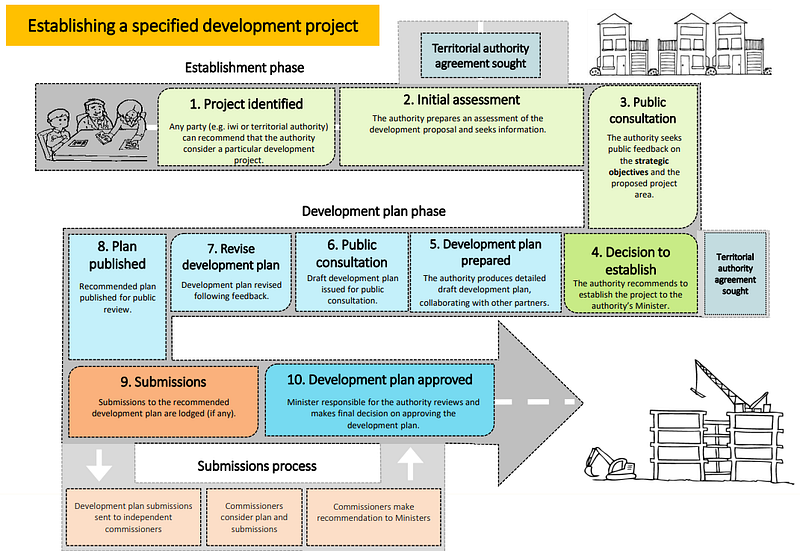
UDA development projects will have the following enabling powers.
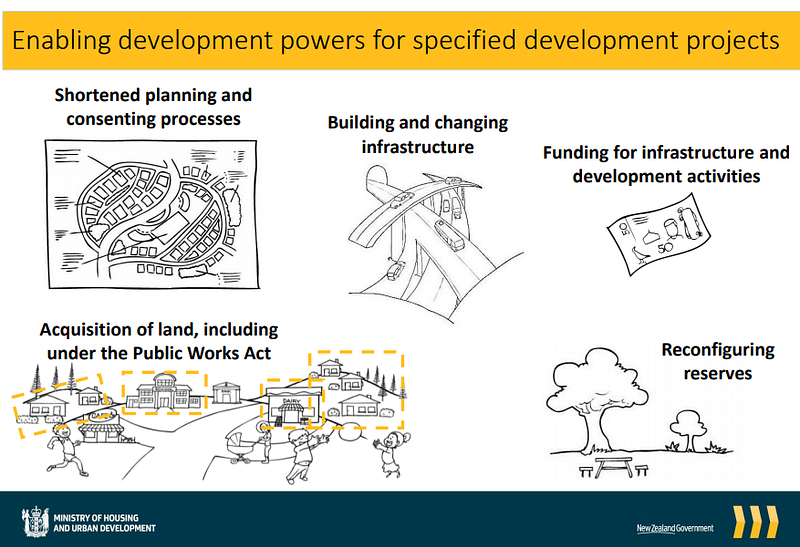
These enabling powers are further specified here.
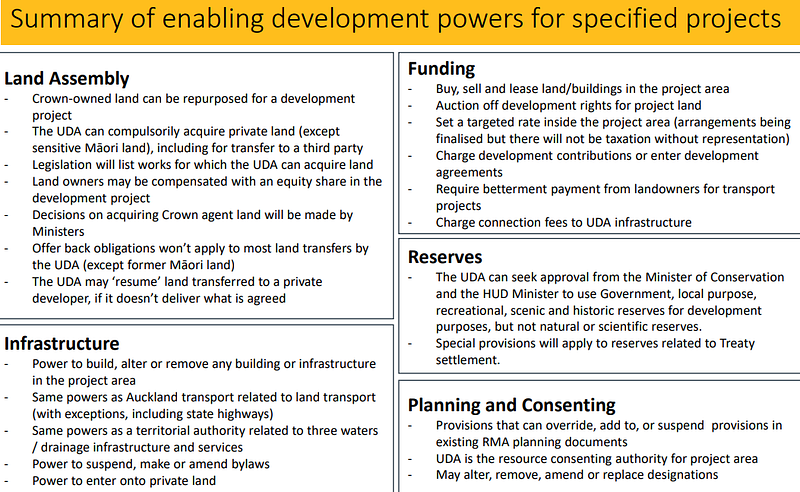
Housing and Transport Minister Phil Twyford has laid out a policy agenda for how Kiwibuild will achieve its housing targets. But it is not his job to implement this policy or even to appoint the head of Kiwibuild, that is the job for New Zealand’s civil service.
What are the skills the new boss of Kiwibuild needs?
There are the obvious required skills, such as, knowledge of the construction sector, a sound understanding of procurement policy and fiscal responsibility. Evidence of motivational and leadership skills whilst implementing significant change projects. The New Zealand governance skill of knowledge of Treaty of Waitangi obligations -especially considering the poor housing of New Zealand’s Maori and other ethnic minorities. And so on.
There are some less obvious skills that the next Kiwibuild boss should have. They need to be a;
Historian
They need to understand that New Zealand has a long history of state built housing, in which many mistakes and successes have been learnt.
State built housing in New Zealand started when the Liberal government enacted the 1905 Workers Dwelling Act to build homes for workers in the outskirts of cities, in places like Petone. This 1905 housing initiative was unsuccessful -only a few hundred of the planned 5000 houses were built. Chiefly because the housing was too expensive and located outside the limits of tram or train services. A lack of affordable and fast transport meant workers could not access city labour markets needed to pay for the housing.
State housing by the first Labour government was relatively successful from the 1930s to 50s. Tens of thousands of houses were built. It gave affordable rental housing for a wide group of medium to low income workers around train stations -especially in the Wellington region. The major criticism I have with this housing model was this state housing lacked density, the houses were typically standalone houses on large plots of land. This affected the economics of the rail services, meaning that public transport required ongoing subsidies and political support, which it didn’t always receive.
Later state housing was built in car centric locations, especially in Auckland. Plans for Auckland’s rail based development were shelved in the 1950s. This led to housing without amenities. Changes to state housing policy by the governments of the 1950s and 60s meant the focus shifted to providing subsidised housing to a much narrower band of lower income tenants. State housing became social housing for the most vulnerable groups in society, such as beneficiaries. Frequently these beneficiaries were attacked politically. These factors all combined to cause slums and entrenched poverty in state housing suburbs, in places like Mangere.
The last iteration of state led house building was Hobsonville. Being the recent development by HLC, a subsidiary of Housing New Zealand, of a surplus to requirement airbase near Auckland. It went too far the other way by only providing a narrowly conceived commercial return. Hobsonville lacks a high frequency rapid transit service but otherwise its density is good and amenities like parks, schools, shops are also good. Hobsonville unfortunately provides very little social or affordable housing for medium and low income earners. Hobsonville was in John Key’s electorate and he announced that state and affordable housing provisions planned by the earlier Clark government would be economic vandalism. John Key was the Prime Minister during Hobsonville’s early construction years. He cut the plans for a high proportion of affordable and state housing.
This affordability issue remains the major criticism of Hobsonville (and Kiwibuild). There is not enough ‘affordable’ homes selling for below $650,000. Hobsonville’s price list does include some homes for less than that, particularly in the Axis type of apartments, but many more are being sold in the range of $650,000 to $1.2 million. It is widely considered the affordable house price target should be much lower than $650,000
The Coalition Government’s Housing Spokesman Phil Twyford back in May 2018, criticised the previous Government’s housing approach in Hobsonville.
“National took a billion dollar slice of publicly owned real estate at Hobsonville and have essentially sold it into private ownership, It’s been a brilliant success in terms of design and commercially, but what’s the public good benefit there?” Twyford said.
Phil Twyford wants to take the master-planning and mixed-use lessons from Hobsonville and multiply them across New Zealand, but with a much larger share of affordable housing.
“Our model is large urban development projects, master-planned by a master planning agency like the Hobsonville Land Company (HLC) and with development companies that would be set up by our affordable housing authority,” he said.
“The model is for large master-planned, mixed use and mixed income developments. Imagine Hobsonville with a much bigger share of state and community housing, and a bigger share of affordable housing.”
Labour’s housing policy is to build 50,000 Kiwibuild homes in Auckland and another 50,000 homes in the rest of New Zealand, in similarly mixed income and mixed use developments that also include private developers. Phil Twyford talks of doing 10 to 15 master planned developments of the size and scale of Hobsonville in Auckland and presumably a similar number in the rest of New Zealand.
Diplomat
Diplomacy skills will be vitally important.
For a long time in New Zealand, there have been two tribes who have dominated the housing debate. It has been the compact-city tribe against the free-to-sprawl tribe.
The difficulty is that both tribes have strengths but also fatal flaws, especially for Auckland.
This means they can’t be ignored but also that neither tribe can by themselves solve New Zealand’s urban development conundrum.
The flaw of the compact-city tribe is a lack of focus on competitive land-use provision and good infrastructure financing needed for affordable housing.
The free-to-sprawl tribe criticises the compact-city tribe and local government urban plans, such as Auckland’s Unitary Plan, for drip feeding zoned buildable land onto the market, which they contend with quite considerable academic backing is a supply restriction. Even worse, these urban development plans highlight the next block of land to be rezoned for development, which allows land-bankers to purchase that land to sell at high oligopolistic prices, which doubles down on the supply restriction.
The flaw of the free-to-sprawl tribe being the country cannot afford Auckland’s ever more expensive motorways. Also until New Zealand transfers to a full carbon-zero vehicle fleet, automobile dependent sprawl is not helping the country meet its climate change goals.
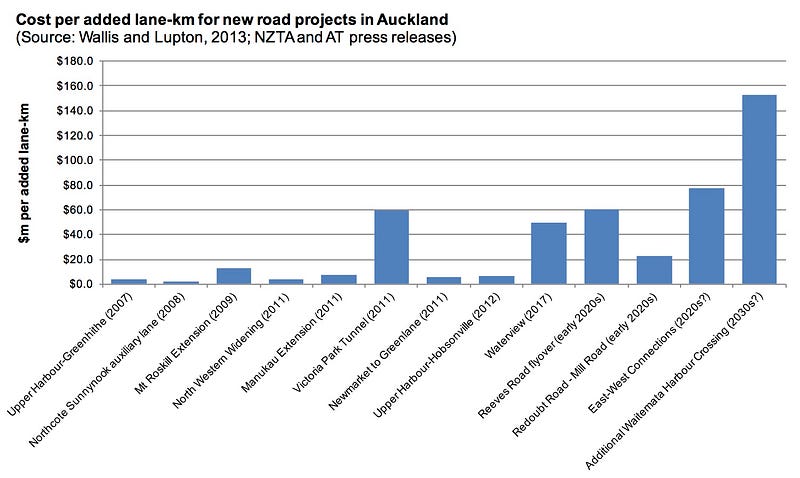
The above cost per added lane-km graph for new road projects clearly shows the increasing costs of motorway provision needed to feed Auckland’s expansion.
This means the urban growth model which Auckland has used since the 1950s, being expansion provided by automobile dependent sprawl, has reached its limits.
Spatial economist
The next Kiwibuild boss needs to have an awareness of spatial economics.
New Zealand towns and cities have land use issues. The land component of housing costs has risen far faster than incomes and the land allocated to transport in the form of motorways, roads and streets is frequently congested.
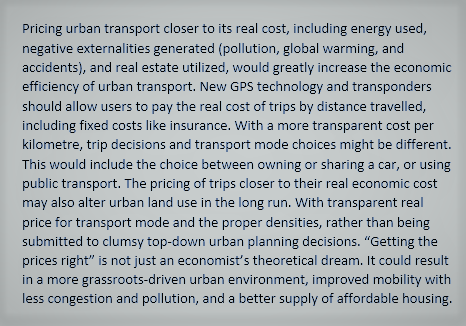
Hopefully the next Kiwibuild boss will read this with light bulbs going off in their head. Quote from “Order without Design - How Markets Shape Cities” by Alain Bertaud P.199
Economists like David Lupton with an understanding of spatial economics propose using congestion road user charges to address the root cause of the growing city problem. Modern technology -such as used by Uber -could in real time measure congestion and vehicle movements, so that users are accurately charged whenever congestion occurs.
Road pricing means congestion is prevented from forming, if demand for travel to a particular place increases -the road price increases. Initially this will shift demand elsewhere -other times, other routes, other modes etc. But if demand and congestion increases to such an extent that there is a significant road price increase, this would induce alternative transport providers to create new space saving travel options -expanding a rapid transit system for instance. Note rising car parking charges in response to demand increases has a similar effect too.
Because the cost of infrastructure is met by the users, restrictions on city expansion can be removed. Private property for urban development can be competitively priced without rationing. If the restrictions on intensification are also removed -such as minimum car parking requirements -then a good proportion of urban development can be ‘grass-roots’ intensification within existing city neighbourhoods.
In effect what David Lupton is advocating for is to correctly price cities publicly owned road and privately owned property spaces to solve problems like congestion, rising infrastructure costs and unaffordable housing. I contend that successful cities need to understand this sort of spatial economics.
The political difficulty of David Lupton’s proposal is that the cities which have some version of road pricing, such as, Singapore, London and Stockholm all have good quality and quantity alternative transport modes. In many New Zealand towns and cities because of auto dependency, road pricing could price out low income users who have no good alternative transport mode options.
Kiwibuilds task should be building affordable housing around rapid transport and other alternative transport options (active mode choices for instance), so that road pricing can be introduced without it being an undue burden on low and middle income earners.
Kiwibuild should cooperate with NZTA’s traffic demand management’s analysis of housing and traffic growth patterns to strategically provide Kiwibuild housing around rapid transit. My ‘Fat Banana’ paper on Greater Christchurch’s population, housing and traffic demand growth is an example of this type of analysis.
Internationalist
The new Kiwibuild boss should be aware of successful overseas housing and transport urban development models. There are multiple potential alternatives. The North American Sightline Institute for instance in an article titled, ‘Yes, You can build your way to Affordable Housing -Lessons From Unexpected Places’, details various options.
They should be aware that Tokyo, a city 25 times the population of Auckland, has houses that are half the price of Auckland. Even better, rail in Tokyo does not need to be subsidised because Tokyo does not spatially subsidise motor cars. There seems to be a positive systemic effect -where competitive transport mechanisms combine with competitive urban housing intensification characteristics to make Tokyo a relatively affordable city.
Kiwibuild should use new funding tools like targeted rates and infrastructure bonds as developed in Texas to help fund the infrastructure for its housing and rapid transit needs. This means housing growth pays for its share of the infrastructure costs.
Another process the next Kiwibuild boss should consider for assembling the land required to build large scale kiwibuild projects is land readjustment mechanisms as used in Germany, Japan, India and an increasing number of Asian countries.
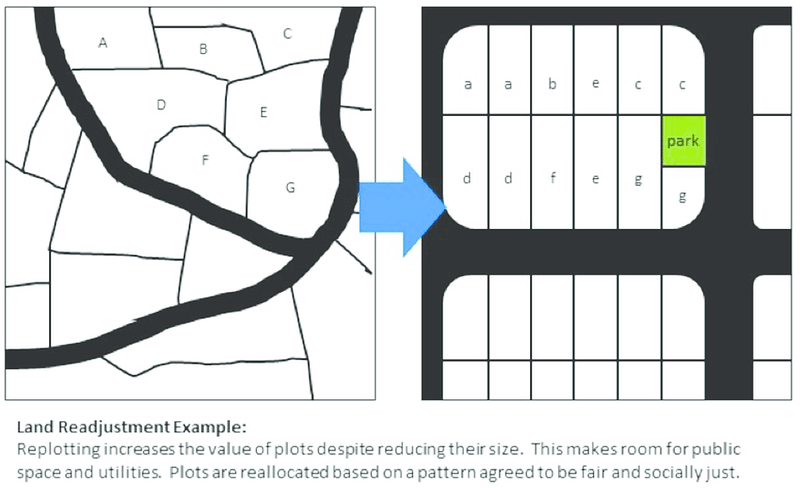
International experience indicates land owners will voluntarily exchange their land for master developed housing schemes, such as Phil Twyford indicates Kiwibuild should undertake, if they are given 25% of the created plots back for their own use (to privately sell). This is because amenities such as streets, parks and rapid transit have increased the value of the land so much, that the original landowners only need to get a small proportion of the land back, in the form of multiple small plots, to be better off financially.
There are several major advantages for this approach.
- It gives landowners an incentive to cooperate.
- Public authorities don’t need financing for the compensation, just grant of title back.
- It leads to more orderly development of strategic sites subdivided into smaller ones, sites that are more accessible without ‘leapfrogging’ and easier to service.
- Landowners don’t need to forward fund the enabling infrastructure.
- It creates subdivided parcels with multiple landowners and potential developers, just what we want to see in oligopolistic markets.
The policy tools that Phil Twyford is giving to the Housing and Urban Development Authority, that I detailed at the beginning of this paper, would be perfect to undertake such land readjustment processes.
This approach would avoid the problem of drip feeding zoned buildable land onto the market causing supply restrictions. Whilst having the advantage of being able to develop land in optimal locations to higher densities around rapid transit.
The created plots could be divided in something like the following proportions;
- 25% back to the original landowners for market rate housing
- 50% to Kiwibuild for affordable but unsubsidised owner occupied housing
- 5–10% to State housing for subsidised rental housing
- 15–20% to the rapid transit provider for unsubsidised commercial and residential rentals
Allocating plots of land for long term rental to the rapid transit provider would encourage it to develop a commercial and residential service culture which is one of the secrets for why Japan’s commuter rail system has succeeded with a low level of public funding subsidy.
Conclusion
Appointing the next Kiwibuild boss is going to be tough ask for New Zealand’s civil service. For the good of the country I hope they make an outstanding appointment.
This is a repost of an article here. It is here with permission.
20 Comments
The idea of further intensifying Auckland surely is lunacy. It can only create more traffic congestion and its expensive to develop.
You can't use the price of motorways and roads built through urban areas as the price of new ones to service fringe development. Napier/Hastings seems to have done this cheaply and well by using expressways and large roundabouts. What is needed is more greenfield employment areas at the outskirts (Apple has just done this in Silicon Valley) to reverse the traffic flows in peak times. We need LESS people living and working in the existing built up areas, not more.
If given the choice there is little natural demand for overpriced high density areas like Hobsonville Point - its just that you are not allowed to build on most of the land In Auckland - seems it has to be reserved for lifestyle blocks with two horses on it.
So to clarify Roger your solution to the housing crisis in Auckland is to build more motorways in towns like Napier and Hastings?
Like Napier/Hastings not in Napier/Hastings
.Correct costs of NZ greenfield motorways is around $5M per lane km at the mo - and this is rolls royce stuff. A dual carriageway with roundabouts might be around $2M, If you use this figure instead of your graph your entire argument is undermined
Whatever scheme gets underway, whenever it does, it is going to be surely under all sorts of pressure, politically and economically, to get things done fast. NZ does not have good history when building goes on in a hurry. LHS & Canterbury EQ repairs for instance. Builders from overseas I have met here are aghast at some of the slipshod practices and loose regulations. We ourselves have seen two houses recently completed where the builders resorted to short cuts and tried to get away with some appallingly slack and sloppy detailing. Suggests to me that our building standards generally, are nowhere near as good as NZ says they are. But that is just my take after all. Does anybody have a link/survey as to where NZ sits internationally with regard to the quality of its building?
Good point Foxglove the mantra should be building at 'pace, scale and quality'. Not just pace and scale.
The first generation state houses built by the Savage govt were built soundly. They have stood the test of time.
Kiwibuild needs to instill that quality ethos into their houses.
Here are some examples of where we sit internationally with the quality of our buildings.
https://en.wikipedia.org/wiki/Leaky_homes_crisis
https://www.branz.co.nz/
https://www.gib.co.nz/
https://www.jameshardie.co.nz/
http://www.fletcherconstruction.co.nz/
Another great example http://www.aplnz.co.nz/
APL windows company make the standard NZ junk with aluminium frames. They have have gobbled up 3 or 4 different window companies. No wonder there is no competition!
I paid $450 from my building consent to these pricks at BRANZ, also they can narrow my selection of building products down to NZ junk.
Another good one would be the various waffle/raft style foundations. As there is no "standard" way to do it from common materials like polystyrene and concrete you have to buy into an engineers solution. This whole industry is foxes guarding hen houses.
Plenty have tried to replicate the original, but there is only one RibRaft® floor, and only Firth RibRaft® carries a CodeMark® certificate.
Too much paper work and not enough standards. For example in the states they tend to double skin their houses - ply then cladding. It probably increases the price by a couple of grand but means it will never leak or fall over. instead we have tons of expensive paperwork and then save money on the actual build to make up for it. Forget all the paperwork and engineers etc for residential houses - just over engineer everything so it’s always good, I reckon it would probably end up cheaper.
Thanks Nzdan, appreciated. Just a glance at Branz section “ Eliminating Quality Issues” is enough for me. That in itself reveals that this area is well recognised as a very long-standing problem which is likely, more likely certain in fact, to pervade a widespread and rapid build program. I mean, If existing quality issues are already suspect, how the heck are they going to be corrected and managed? What will be the durability? Down the line, who pays to correct the faults and failures?
There are all sorts of criticisms about KiwiBuild being too expensive; in the wrong place etc. but is it?
The best place to attack an overprices property sector is 'in the middle'. It avoids distorting the whole market and can lower the entire market, progressively, over time. Provide more stock 'in the middle' and it takes demand away from the bottom ( where currently stretched New Zealanders are forced to buy) and gives The Top an expanded market to down-grade into. The view that KiwiBuild is about 'affordable housing' gives the impression that it's a re-run of all the other social housing schemes mention in this article; building at The Bottom, but I reckon - it is, and should be, different this time ( famous last words!)
The too expensive argument is rubbish. Why would a brand new double glazed insulated house be at the bottom end of the market when we have so many old uninsulated ice boxes? It’s like expecting the government trying to bring down car prices by building new cars for cheaper than very old second hand ones.
Well, if brand new double glazed insulted houses are selling for less than old uninsulated ice boxes, then you've effectively set a price ceiling on uninsulated ice boxes. Unless of course these ice boxes are in demand because they offer something else these new houses don't offer.
A front lawn you can swing a cat in springs to mind..
I do not think the above would be a recipe for success. The fact is the article is too lengthy.
What the Kiwibuild boss needs is the skills to coordinate a functional team to get houses built. Where Government Departments fail is they fill up with committees, policy analysts and lawyers. Nothing can be done efficiently if management is weighed down with people that are useless for design and construction.
The projects should be initiated in parallel which means having multiple teams preparing projects. There's no place in these teams for useless muppets.
Given that the Government shouldn't be the only piece of the solution there need to be changes to the building code, and Councils need to be brought back under control so they operate within New Zealand law. That would at least contribute to reducing the cost of housing, and reduce delays (you know, the same reason Kiwibuild was given special powers to go over the heads of terrible Councils).
I doubt the previous boss who did nothing for months would have made anything happen anyway even if he tried. In fact the person they will probably hire won't be able to make what I've stated above actually happen. I think the best the Government can hope for in the best case is someone that won't wreck the HNZ part of the Commission.
So they tie the private sector up in regulatory knots for 20 years, then wonder why we have a housing shortage.
And then they remove all the need for planning regulations for what they are doing.
They should just remove the constraints and get out of the way.
There isn’t a housing shortage per say but there is an affordable housing issue. The reasons are large amounts of money and credit coupled with increased immigration.
The requirements imposed by the regulations add a lot of cost. It is a barrier to creating affordable housing.
— —
We welcome your comments below. If you are not already registered, please register to comment
Remember we welcome robust, respectful and insightful debate. We don't welcome abusive or defamatory comments and will de-register those repeatedly making such comments. Our current comment policy is here.